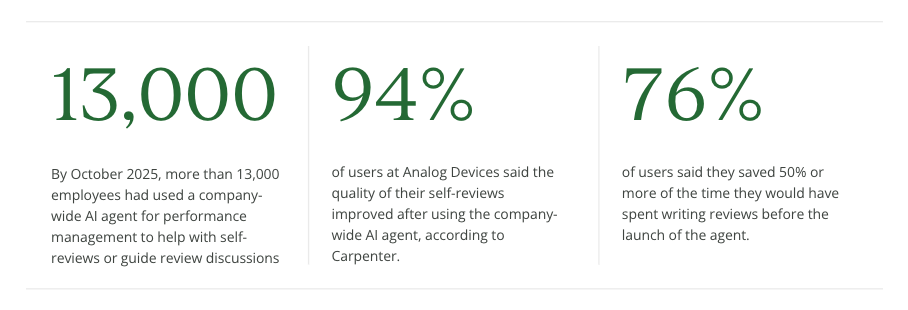It was the week after Thanksgiving in 2022, and Jennifer Carpenter had eight performance reviews to finish writing on a tight deadline. Now Global Head of Talent for Analog Devices, Carpenter was then working for IBM and had been an early adopter of artificial intelligence features in her tools at work for years.
But ChatGPT’s launch just days earlier got her thinking: Why not put those tools to work writing reviews? Within minutes, she had well-crafted drafts for her team’s reviews that she could expand upon and submit.
Fast forward a year, and Carpenter was using ChatGPT to build a writing agent prototype for a test case of leaders. Then a year after that—by last October—she had released a company-wide agent that more than 13,000 people at Analog Devices have used to help write their self-reviews or guide their review discussions. Some 94% of users said the quality of their self-reviews improved, and 76% said they saved 50% or more of the time they would have spent writing.
“Talk about cheap and cheerful,” Carpenter told Modern. “We estimate the time to production was about a month, the cost was minimal, and everyone was happy to have the help.”
Carpenter has since created several AI agents—including ones that have helped build skills taxonomies and write job descriptions. And she’s an outspoken advocate for more talent leaders getting personally involved with building agents, embracing AI, and finding ways to “manage the flow of work” at a time when the shape and structure of jobs are being disrupted.
Below, here are five hard-earned insights Carpenter has learned from what she calls her “adventures in AI,” in hopes others will embark on their own adventures, too.
1. Lean into experimentation.
Having a deadline for writing performance reviews might be an incentive. So might a tight budget, limited resources, or an unwieldy amount of data. “You have to experiment when you have 30 days to create a skills taxonomy,” Carpenter says. “When you have to be resourceful, it fuels creativity and innovation.”
For as little as $20 a month, Carpenter says, it’s simple for talent leaders early in their AI journey to experiment with creating their own agents using any number of platforms. At ADI, they created an agent to write hundreds of job descriptions in just a few days and loaded them into Workday. Now when hiring managers request hiring support, they are presented with a well-written, “on brand” job description they can edit, saving thousands of hours each year companywide.
Carpenter says a job descriptions agent is a low-risk project one person can complete in a couple of days, whereas creating that kind of consistency and accuracy across job profiles in the past would have taken monumental effort. With AI, she says, “the barrier to entry on both cost and difficulty is a lot lower than many of my colleagues across talent and HR realize. You can do this yourself.”
2. Look for real pain points to drive AI adoption.
No one likes writing job descriptions. No one likes having difficult performance conversations. No one likes asking naïve questions to their manager.
Getting AI to help with these undesirable activities at work can go a long way to driving adoption. Says Carpenter: “Getting an agent behind your firewall, where people can feel like they can ask a stupid question or practice something when they don't want to ask their boss for help, can make them feel more supported.”
"We have such an incredible opportunity to shape the strategies for our companies."—Analog Devices Global Head of Talent Jennifer Carpenter
AI can also help keep the focus on what matters. “Performance management processes often collapse under the weight of the documentation,” she says, when the focus should be about the conversation. By saving time organizing thoughts and suggesting coaching tips, AI has “helped people who don't normally do this very well or very often improve both the feedback they document and most importantly, how it’s delivered.”
Carpenter says Analog Devices is now training an AI coach that knows the company’s new career development framework to help as a writing assistant for reviews. That takes the conversation a step further, offering managers the chance to role-play a coaching conversation in one of more than 180 languages that might emerge from the review discussion.
3. Build more ‘pilots’ than ‘passengers’ in your organization by measuring mindset—and more.
Carpenter says she has been measuring AI-ready “mindset” at Analog Devices over the past two years. She’s asked people both how optimistic they are that AI is going to improve the quality and productivity of their work, and how much personal agency they have. Are they confident in their own abilities to work with AI tools?
Doing so helps her determine how many “passengers” and “pilots” she has in the organization, a concept introduced in research from BetterUp Labs and Stanford University's Social Media Lab. Pilots are optimistic about AI and have a high degree of confidence in their abilities. Passengers are more negative about AI and use it minimally. “None of us know how our work and the work of our organization is going to change as a result of AI,” Carpenter says. “But if you have a pilot mindset, you can navigate this disruption.”

Carpenter says it’s talent leaders’ job to understand where the organization’s mindset is. “We don't want to leave behind our passengers, but when budgets are small and you don't know where to start, you have to continue to get those pilots in the front of planes by equipping them and observe how AI adoption takes off.”
Carpenter advises having your own set of research questions to help frame the narrative you’re trying to sell about the opportunities with AI. “We have such an incredible opportunity to shape the strategies for our companies,” she says. “Outline your measurement strategy early. The most thrilling part of my job is studying how quickly employee sentiment and mindset is changing. What we learn shapes strategy, giving us answers to complex questions and enabling us to adapt quickly.”
4. Extend invitations rather than forcing enablement.
How should you introduce new AI tools? “I can tell you what NOT to do,” Carpenter says. “I learned the hard way.” She thought employees in an initial pilot group would share her excitement and all use it immediately. But in the first 30 days, only 10% had activated their license.
Carpenter realized that sending invitations—especially to those people whose mindset matched the high-optimism, high-agency “pilots”—helped get things rolling. If something is just made available, people question whether they have time to learn it. They’re unsure whether to trust it and uncertain how it can benefit them. “We have to be dot-connectors” as talent leaders, Carpenter says. “What I learned from assuming everyone would want to come to the AI party is that they need to feel invited first with a compelling reason to RSVP.”
5. Recognize your value has shifted—from delivering output to being a ‘work architect’ who understands the flow of work.
After several years of experimenting with AI and building agents for her talent teams, Carpenter says she’s had a “terrifying” realization: Much of what she’s built her career on—delivering output—can be done a lot faster and better by LLMs. “What is our value as talent leaders now? How can HR see AI as an opportunity, not a threat?”
She started to realize that AI can help systematize a messy, one-time effort into more structured, reusable patterns. “What if we can see where decisions stall in our company, where handoffs break down, and where AI can add the most value? Understanding the motion of work is HR’s new superpower.”
"The future-ready CHRO is going to become a work architect who understands the flow of work."—Carpenter
With AI, she says, leading teams is not about automation and delegation of tasks. It's about collaboration with clarity. “The future-ready CHRO is going to become a work architect who understands the flow of work. Our value has shifted from output to redesigning the motion of work.”
Carpenter is optimistic when it comes to the power talent leaders will have in the future. “We are now in the driver’s seat. Not only are we at the table with the CEO. We can lead the cross-functional effort, map the key workflows, identify the friction points, and strategically integrate AI as a force multiplier.
HR leaders, she says, can help organizations see AI as a catalyst for better-designed work. “You don’t need to become an AI expert,” Carpenter says. “You need to become an expert in how work actually works.”
.png)


